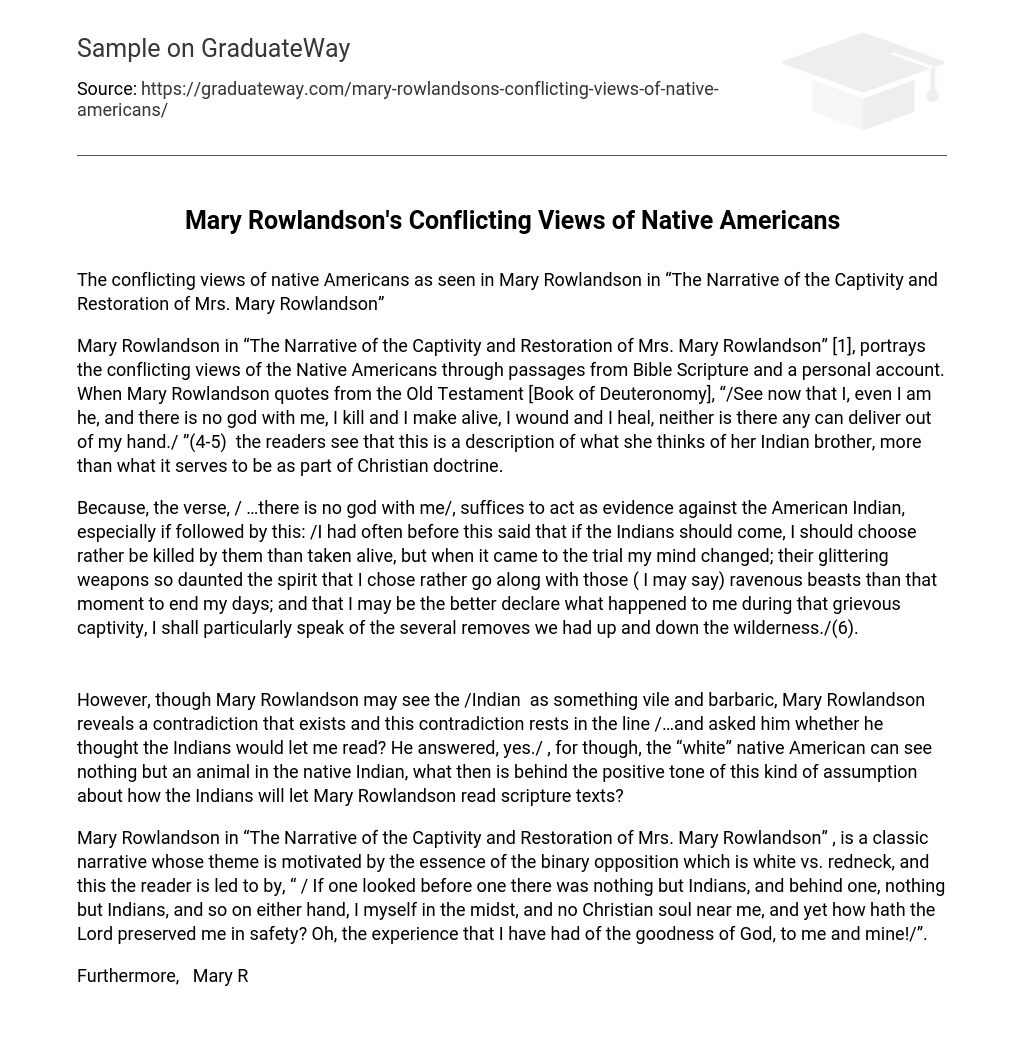The conflicting views of native Americans as seen in Mary Rowlandson in “The Narrative of the Captivity and Restoration of Mrs. Mary Rowlandson”
Mary Rowlandson in “The Narrative of the Captivity and Restoration of Mrs. Mary Rowlandson” [1], portrays the conflicting views of the Native Americans through passages from Bible Scripture and a personal account. When Mary Rowlandson quotes from the Old Testament [Book of Deuteronomy], “/See now that I, even I am he, and there is no god with me, I kill and I make alive, I wound and I heal, neither is there any can deliver out of my hand./ ”(4-5) the readers see that this is a description of what she thinks of her Indian brother, more than what it serves to be as part of Christian doctrine.
Because, the verse, / …there is no god with me/, suffices to act as evidence against the American Indian, especially if followed by this: /I had often before this said that if the Indians should come, I should choose rather be killed by them than taken alive, but when it came to the trial my mind changed; their glittering weapons so daunted the spirit that I chose rather go along with those ( I may say) ravenous beasts than that moment to end my days; and that I may be the better declare what happened to me during that grievous captivity, I shall particularly speak of the several removes we had up and down the wilderness./(6). However, though Mary Rowlandson may see the /Indian as something vile and barbaric, Mary Rowlandson reveals a contradiction that exists and this contradiction rests in the line /…and asked him whether he thought the Indians would let me read? He answered, yes./ , for though, the “white” native American can see nothing but an animal in the native Indian, what then is behind the positive tone of this kind of assumption about how the Indians will let Mary Rowlandson read scripture texts?
Mary Rowlandson in “The Narrative of the Captivity and Restoration of Mrs. Mary Rowlandson” , is a classic narrative whose theme is motivated by the essence of the binary opposition which is white vs. redneck, and this the reader is led to by, “ / If one looked before one there was nothing but Indians, and behind one, nothing but Indians, and so on either hand, I myself in the midst, and no Christian soul near me, and yet how hath the Lord preserved me in safety? Oh, the experience that I have had of the goodness of God, to me and mine!/”.
Furthermore, Mary Rowlandson in “The Narrative of the Captivity and Restoration of Mrs. Mary Rowlandson” shows the reader that the “white” native American endures in his goal to be aided by and to hold steadfastly unto, his Christian faith, including the lines, “/ I have something at hand to check myself with, and say, why am I troubled? It was but the other day that if I had had the world, I would have given it for my freedom, or to have been a servant to a Christian./ ”, and, “ / I have learned to look beyond the present and smaller troubles and to be quieted under them. As Moses said, “ Stand still and see the salvation of the Lord” (Exodus 14.13)./ ”
Whereas, the red-skinned native American, the Indian, is removed from his previous position of power, because, in the eyes of Mary Rowlandson, the Indian is not a Christian. And what else can be more powerful, than faith in the Lord?
Mary Rowlandson in “The Narrative of the Captivity and Restoration of Mrs. Mary Rowlandson”. Project Gutenberg Literary Archive Material: 1993. EE.





